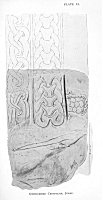
Sacred Texts Legends/Sagas Celtic Iceland Index Previous Next


Click to enlarge
PLATE I. UNINSCRIBED CROSS-SLAB, JURBY.
ODIN CARRIES THE HERO TO VALHALL.

Click to enlarge
UNINSCRIBED CROSS-SLAB, JURBY. (obverse)
We are now able, by means of the old Norse Mythology, to explain a strange figure on an uninscribed fragment from Jurby. To understand it aright we must bear in mind that Odin is ever eager to bring the greatest champions to Valhall to share in the joyous lives of the gods, and to be ready at the great Day of Doom to sally forth with them and do battle with the monsters and the demons. We must remember, too, that it is by hanging a man is dedicated to Odin.
At the left of the lower part of the shaft of a cross we
see a man with a pole over his shoulder, from the end of which a smaller being is hanging 1 (pl. I.).
Now there is in the Norse heroic Sagas an old story of the sacrifice of King Wiker by Starkad, Odin's foster-son, who marked him with the spear, and dedicated him to Odin. 2 But, as Professor Sophus Bugge points out, 3 the motives from the Volsunga Saga are those most frequently represented on the Manks stones, and it seems altogether more likely that the reference here is to Randver, Jormanrek's son, whom Odin, under the guise of Bikke, the evil counsellor, persuaded his aged father to sacrifice by hanging, as related in the "Prose Edda, Gudrúnarhvot."
There are other instances of Odin's intervention to secure the death of heroes, and so bring them to Valhalla. That it is meant for Odin is confirmed by the fact that it has a bird's head, and Arnhofði (Eagle-headed) is one of Odin's names.
The bearded figure above in a long robe, armed with a trident, may possibly be intended for the aged Jormanrek.
On the other side of the cross Valhall is signified by the figures of the Boar and the sacred Hart--
Above is the Boar Sæhrimner, food of the heroes in Valhall, who hunt and slay and feast upon him, and afterwards Thor waves his hammer over the bones and restores him to life. An interesting point to us is that the Boar
is of Celtic origin. The great Irish Sea-god, after whom our island is supposed to be named--Mannu--owned the pig which was killed and eaten and again restored to life!
Above the Boar we see remains of a design which may be intended for a shield, as suggested by Dr. S. Bugge, representing the shield-panelling of Valhall.
On the other face of the stone (pl. II.) is a curious circular design of agglomerated flat pellets within a border of step-pattern Can this be a reference to the roof of golden shields?
19:1 In a paper on Saga Illustrations on Manks Monuments, Viking Club Saga Book, 1895-6, I took this to be the capture of Loki, but the above seems a more likely explanation.
19:2 Gautreks S., ch. 7--"Corp. Poet. Bor.", I, 466-7.
19:3 Nordiske Runeindskifter, &c., Saertryk of Aarb. for Nord Oldkynd og Hist., 1899, p. 253.